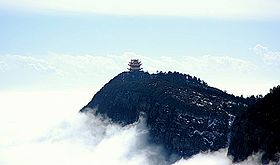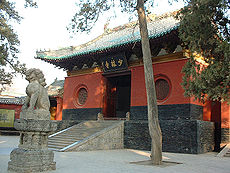- Mount Emei
-
"Omei Shan" redirects here. For the bird, see Grey-faced Liocichla.
"峨眉山" redirects here. For the county-level city that Mount Emei is located in, see Emeishan City
Mount Emei Scenic Area, including Leshan Giant Buddha Scenic Area * UNESCO World Heritage Site
Country People's Republic of China Type Cultural and Natural (Mixed) Criteria iv, vi, x Reference 779 Region ** Asia-Pacific Inscription history Inscription 1996 (20th Session) * Name as inscribed on World Heritage List
** Region as classified by UNESCOMount Emei Emei Shan Emeishan City, Sichuan Elevation 3,099 m (10,167 ft) Location Coordinates 29°31′11″N 103°19′57″E / 29.51972°N 103.3325°ECoordinates: 29°31′11″N 103°19′57″E / 29.51972°N 103.3325°E Part of the series on
Chinese martial artsList of Chinese martial arts Terms Historical places - Shaolin Monastery (少林寺)
- Wudang Mountains (武當山)
- Mount Hua (華山)
- Mount Emei (峨嵋山)
- Kunlun Mountains (崑崙山)
Historical people - Five Elders (五祖)
- Yim Wing-chun / Yan Yongchun (嚴詠春)
- Hung Hei-gun / Hong Xiguan (洪熙官)
- Fong Sai-yuk / Fang Shiyu (方世玉)
- Dong Haichuan (董海川)
- Yang Lu-ch'an (楊露禪)
- Wu Quanyou (吳全佑)
- Ten Tigers of Canton (廣東十虎)
- Chen Fake (陳發科)
- Chan Heung / Chen Xiang (陳享)
- Wong Fei-hung / Huang Feihong (黃飛鴻)
- Sun Lu-t'ang (孫祿堂)
- Huo Yuanjia (霍元甲)
- Yip Man / Ye Wen (葉問)
- Wang Zi-Ping (王子平)
- Bruce Lee / Li Xiaolong (李小龍)
- Jackie Chan / Cheng Long (成龍)
- Sammo Hung / Hong Jinbao (洪金寶)
- Yuen Biao / Yuán Biāo (元彪)
- Jet Li / Li Lian Jie (李連杰)
- Donnie Yen / Zhēn Zǐdān (甄子丹)
Legendary figures - Bodhidharma / Putidamo / Damo (菩提達摩)
- Zhang Sanfeng (張三丰)
- Eight immortals (八仙)
Related Mount Emei (Chinese: 峨嵋山; pinyin: Éméi Shān; Wade–Giles: O2-mei2 Shan1, pronounced [ɤ̌měɪ̯ ʂán]) is a mountain in Sichuan province, China. Mount Emei is often written as 峨眉山 and occasionally 峩嵋山 or 峩眉山 but all three are translated as Mount Emei or Mount Emeishan: 峨嵋 means "lofty brow", but the mountain's name is merely a toponym that carries no additional meaning.
Orographically, Mt. Emei sits at the western rim of the Sichuan Basin. The mountains west of it are known as Daxiangling.[1] A large surrounding area of countryside is geologically known as the Permian Emeishan Large Igneous Province, a large igneous province generated by the Emeishan Traps volcanic eruptions during the Permian Period. At 3,099 metres (10,167 ft), Mt. Emei is the highest of the Four Sacred Buddhist Mountains of China.[2]
Administratively, Mt. Emei (Emeishan) is located near the county-level city of the same name (Emeishan City), which is part of the prefecture-level city of Leshan.
Mt. Emei was made a UNESCO World Heritage Site in 1996.[3]
Contents
As the bodhimaṇḍa of Samantabhadra
Mount Emei is one of the Four Sacred Buddhist Mountains of China, and is traditionally regarded as the bodhimaṇḍa, or place of enlightenment, of the bodhisattva Samantabhadra. Samantabhadra is known in Mandarin as Pǔxián Púsà (普賢菩薩).
16th and 17th century sources allude to the practice of martial arts in the monasteries of Mount Emei[4] made the earliest extant reference to the Shaolin Monastery as Chinese boxing's place of origin.[5]
Buddhist architecture on Emei
This is the location of the first Buddhist temple built in China in the 1st century CE.[3] The site has seventy-six Buddhist monasteries of the Ming and Qing period, most of them located near the mountain top. The monasteries demonstrate a flexible architectural style that adapts to the landscape. Some, such as the halls of Baoguosi, are built on terraces of varying levels, while others, including the structures of Leiyinsi, are on raised stilts. Here the fixed plans of Buddhist monasteries of earlier periods were modified or ignored in order to make full use of the natural scenery. The buildings of Qingyinge are laid out in an irregular plot on the narrow piece of land between the Black Dragon River and the White Dragon River. The site is large and the winding foot path is 50 km, taking several days to walk.[6]
Cable cars ease the ascent to the two temples at Jinding (3,077 m), an hour's hike from the mountain's peak.[2][7]
Sunrise and clouds sea
Great spectacles of Mount Emei include the sunrise and Clouds Sea seen from the Golden Summit of the mountain.
The sunrise is very varied, but optimally begins with the ground and sky being in the same dark purple, soon showing rosy clouds, followed by a bright purple arc and then a semicircle where the sun is coming up.[8]
The Clouds Sea includes several cloud phenomena, e.g. clouds appearing in the sky above, in addition to the regular clouds beneath.[8]
Climate
The summit of Mount Emei has an alpine subarctic climate (Köppen Dwc), with long, cold (but not severely so) winters, and short, cool summers. The monthly daily average temperature ranges from −5.7 °C (21.7 °F) in January to 11.6 °C (52.9 °F), and an annual mean of 3.07 °C (37.5 °F). Precipitation is common year-round, but due to the influence of the monsoon, rainfall is especially heavy in summer, and more than 70% of the annual total occurs from June to September.
Climate data for Mount Emei (1971−2000) Month Jan Feb Mar Apr May Jun Jul Aug Sep Oct Nov Dec Year Record high °C (°F) 16.7
(62.1)18.5
(65.3)20.5
(68.9)22.7
(72.9)21.7
(71.1)22.5
(72.5)22.1
(71.8)21.5
(70.7)19.8
(67.6)19.3
(66.7)19.5
(67.1)16.3
(61.3)22.7
(72.9)Average high °C (°F) −0.3
(31.5)0.4
(32.7)4.1
(39.4)7.8
(46.0)10.5
(50.9)12.9
(55.2)15.2
(59.4)14.9
(58.8)11.2
(52.2)7.2
(45.0)4.0
(39.2)1.6
(34.9)7.5 Average low °C (°F) −9.2
(15.4)−8.1
(17.4)−4.8
(23.4)−0.3
(31.5)3.6
(38.5)6.8
(44.2)9.2
(48.6)9.0
(48.2)5.5
(41.9)1.2
(34.2)−3.2
(26.2)−6.8
(19.8)0.2 Record low °C (°F) −19.2
(−2.6)−19.1
(−2.4)−17.2
(1.0)−9.8
(14.4)−7.4
(18.7)−0.2
(31.6)2.1
(35.8)2.8
(37.0)−3.5
(25.7)−11.1
(12.0)−14.7
(5.5)−19.7
(−3.5)−19.7
(−3.5)Precipitation mm (inches) 15.4
(0.606)23.8
(0.937)50.3
(1.98)112.1
(4.413)161.6
(6.362)220.1
(8.665)366.5
(14.429)428.4
(16.866)210.8
(8.299)101.4
(3.992)42.8
(1.685)16.0
(0.63)1,749.2
(68.866)Avg. precipitation days (≥ 0.1 mm) 16.9 19.1 22.3 22.3 23.2 23.6 22.7 21.9 23.8 24.7 20.0 15.1 255.6 Source: Weather China Indigenous animals
Visitors to Mount Emei will likely see dozens of Tibetan Macaques who can often be viewed taking food from tourists. Local merchants sell nuts for tourists to feed the monkeys. Some monkeys may be seen eating human food such as potato chips and even drinking soda from discarded bottles.
The Emei Shan Liocichla, a passerine bird is named after the site.
Gallery
-
Macaque indigenous to the region
See also
- Sacred Mountains of China
- Emei Sect
- Zuo Ci
References
- ^ E.g., 使用中国地图集 (Shiyong Zhongguo Dituji, "Practical Atlas of China"), 2008, ISBN 978-7-5031-4772-2; map of Sichuan on pp. 142-143
- ^ a b Hayes, Holly (2009) Emei Shan, Sacred Destinations. Updated 24 July 2009.
- ^ a b "Mount Emei Scenic Area, including Leshan Giant Buddha Scenic Area". UNESCO. http://whc.unesco.org/en/list/779. Retrieved 2007-09-06.
- ^ Zhāng Kǒngzhāo 張孔昭 (c. 1784) (in Chinese). Boxing Classic: Essential Boxing Methods 拳經拳法備要 Quánjīng Quánfǎ Bèiyào.
- ^ Henning, Stanley E. (Fall 1999a). "Academia Encounters the Chinese Martial Arts". China Review International 6 (2): 319–332. doi:10.1353/cri.1999.0020. ISSN 1069-5834..
- ^ Dazhang, Sun (2002). Chinese Architecture -- The Qing Dynasty (English ed.). Yale University Press. pp. 328–329. ISBN 0-300-09559-7.
- ^ Gluckman, Ron (2002). Getting to the Top, Silk Road, December 2002. Hong Kong; Dragon Airlines.
- ^ a b Dreams Travel - Four Great Spectacles of Mt. Emei Retrieved on April 12, 2009
Further reading
External links
- Mount Emei travel guide from Wikitravel
- Religion and the environment in China, 中国的宗教与环境 - chinadialogue article
- Mount Emei, including Leshan Giant Buddha, Scenic Area: official Unesco site
- Tours and Travel to total Solar Eclipse 2009 to China on Mt. Emei Shan
World Heritage Sites in China East Classical Gardens of Suzhou · Fujian Tulou · Lushan National Park · Mount Huang (Huangshan) · Mount Sanqing (Sanqingshan) · Mount Tai (Taishan) · Mount Wuyi (Wuyishan) · Temple and Cemetery of Confucius and Kong Family Mansion, Qufu · Ancient villages in Southern Anhui - Xidi and Hongcun · West Lake Cultural Landscape of Hangzhou
South Central Ancient Building Complex in the Wudang Mountains · Historic Centre of Macau · Kaiping Diaolou and Villages · Longmen Grottoes · Historic Monuments of Dengfeng, including the Shaolin Monastery and Gaocheng Observatory · Wulingyuan Scenic and Historic Interest Area · Yin Xu
Southwest Dazu Rock Carvings · Historic Ensemble of the Potala Palace, including the Jokhang and Norbulingka · Huanglong Scenic and Historic Interest Area · Jiuzhaigou Valley Scenic and Historic Interest Area · Old Town of Lijiang · Mount Emei Scenic Area, including Leshan Giant Buddha Scenic Area · Mount Qingcheng and the Dujiangyan Irrigation System · Sichuan Giant Panda Sanctuaries · Three Parallel Rivers of Yunnan Protected Areas
North Mount Wutai (Wutaishan) · Chengde Mountain Resort and its outlying temples including the Putuo Zongcheng Temple, Xumi Fushou Temple and the Puning Temple · Imperial Palaces of the Ming and Qing Dynasties in Beijing and Shenyang · Peking Man Site at Zhoukoudian · Ancient City of Pingyao · Summer Palace, an Imperial Garden in Beijing · Temple of Heaven: an Imperial Sacrificial Altar in Beijing · Yungang Grottoes
Northeast Capital Cities and Tombs of the Ancient Koguryo Kingdom · Imperial Palaces of the Ming and Qing Dynasties in Beijing and Shenyang
Northwest Multiple regions Sacred Mountains of China Five Great Daoist Mountains Four Sacred Buddhist Mountains National parks of China Beidaihe • Benxi Shuidong National Park • Mount Cangyan • Chengde Mountain Resort • Dian Lake • Dujiangyan Irrigation System • Mount Emei • Fuxian Lake • Mount Heng (Hunan) • Mount Heng (Shanxi) • Hexigten Global Geopark • Mount Hua • Huangguoshu Waterfall • Huanglong, Sichuan • Mount Huang • Jade Dragon Snow Mountain • Jinggangshan Mountains • Jiuzhaigou Valley • Mount Lao • Mount Li • Longmen Grottoes • Mount Luofu • Mount Lu • Lushan Quaternary Glaciation National Geopark • Mount Jiuhua • Mount Mogan • Pearl Shoal Waterfall • Pudacuo National Park • Mount Putuo • Qianshan National Park • Mount Qingcheng • Qinghai Lake • Mount Qingyuan • Mount Qiyun • Mount Sanqing • Sanshan Islands • Shilin (Stone Forest) • Mount Song • Taihu Lake • Mount Tai • Mount Tianzhu • Wudang Mountains • Wulingyuan • Mount Wutai • Wuyi Mountains • Xixi National Wetland Park • Yuelu Mountain • Yun Mountain • Zhangjiajie National Forest Park • Wangwushan - Yuntaishan National Park •Categories:- Buddhism in China
- Chinese Buddhist grottoes
- Mountains of China
- National parks of China
- World Heritage Sites in China
- Chinese architectural history
- Sacred mountains
- Geography of Sichuan
Wikimedia Foundation. 2010.












